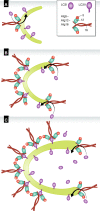Getting ready for building: signaling and autophagosome biogenesis
- PMID: 25027988
- PMCID: PMC4197041
- DOI: 10.15252/embr.201439076
Getting ready for building: signaling and autophagosome biogenesis
Abstract
Autophagy is the main cellular catabolic process responsible for degrading organelles and large protein aggregates. It is initiated by the formation of a unique membrane structure, the phagophore, which engulfs part of the cytoplasm and forms a double-membrane vesicle termed the autophagosome. Fusion of the outer autophagosomal membrane with the lysosome and degradation of the inner membrane contents complete the process. The extent of autophagy must be tightly regulated to avoid destruction of proteins and organelles essential for cell survival. Autophagic activity is thus regulated by external and internal cues, which initiate the formation of well-defined autophagy-related protein complexes that mediate autophagosome formation and selective cargo recruitment into these organelles. Autophagosome formation and the signaling pathways that regulate it have recently attracted substantial attention. In this review, we analyze the different signaling pathways that regulate autophagy and discuss recent progress in our understanding of autophagosome biogenesis.
Keywords: Atgs; autophagosome biogenesis; autophagy; mTOR; signaling.
© 2014 The Authors.
Figures





References
-
- Choi AM, Ryter SW, Levine B. Autophagy in human health and disease. N Engl J Med. 2013;368:651–662. - PubMed
-
- Sato M, Sato K. Dynamic regulation of autophagy and endocytosis for cell remodeling during early development. Traffic. 2013;14:479–486. - PubMed
-
- Weidberg H, Shvets E, Elazar Z. Biogenesis and cargo selectivity of autophagosomes. Annu Rev Biochem. 2011;80:125–156. - PubMed
Publication types
MeSH terms
Substances
LinkOut - more resources
Full Text Sources
Other Literature Sources
Miscellaneous

